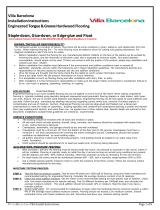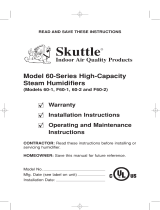
Wood Furniture Care
Perhaps the greatest environmental damage to wood furniture comes from wide swings in
relative humidity (RH) in our homes. Wood absorbs and desorbs water as relative humidity rises
and falls, and in doing so it swells and shrinks. Making matters worse, it expands and contracts
unequally along different grain directions. As humidity changes, the components of wooden
objects are continually pushing and pulling against each other. This pressure often results in
parts of furniture no longer fitting together closely or becoming distorted or breaking from their
own internal stresses.
The response to relative humidity changes begins with determining the annual average RH for
your particular space. Then try to keep the RH in the space where your furniture is as close to
that average as possible, generally within about 10% up or down. De-humidify in the summer
and humidify in the winter.
Be aware that raising the temperature lowers the humidity and vice versa. Thus, modern
heating systems, which can drive down interior RH in the winter, almost invariably cause
problems for furniture. To counteract their effect, you can either modify the RH by keeping
furniture containing spaces cooler in the winter or most importantly, have a good working
humidifier for your home. A humidistat automatically works to balance the humidity in your
home so it is constant. Dry indoor air can suck enough moisture from its surroundings to do
permanent damage to wood, causing it to crack or split.
Remember, that not all woods are created equal. Two factors that help determine how rapidly
a wood will lose moisture are pore size and surface hardness. A piece made from a dense and
hard wood will dry less rapidly than pieces made from softer woods.
Furniture that is sealed and lacquered will lose moisture more slowly than an unfinished piece
while pieces with veneer finishes are not only stronger, but lose moisture more slowly than
other finishes.
To help protect your wood furniture, take these steps:
Use a humidifier, preferably one with an automatic control system that can sense the
humidity level and adjust itself accordingly. Don't over-humidify; that can damage wood
by causing it to expand and contract.
Keep furniture out of direct sunlight, which can cause it to dry out, crack and warp.
If you can avoid it, don't put furniture near heating vents. If you must, keep the piece 3
to 4 inches away from the wall, giving the heat and air space to circulate.
Dust with soft dry cloth.
Do not use liquid or aerosol products.
To avoid marking, do not place rubber ON SURFACE (FOOT PADS, ETC)
For soil build-up, wipe with damp cloth & dry.
Do not use abrasive cleaner.
-
 1
1
Ask a question and I''ll find the answer in the document
Finding information in a document is now easier with AI
Related papers
-
Simpli Home AXCHUN-02 Operating instructions
-
Simpli Home AXCCOR-02-WBR Installation guide
-
Simpli Home AXCHUN-01 Operating instructions
-
Simpli Home AXCBEL-06 Installation guide
-
Simpli Home AXCHUN-08 Operating instructions
-
Simpli Home AXCWAI-01 Installation guide
-
Simpli Home AXWELL3-003RNAB Operating instructions
-
Simpli Home AXCSKL-02 Installation guide
-
Simpli Home AXCWEB-03 Installation guide
-
Simpli Home 3AXCSAW-02-FG Installation guide
Other documents
-
 Villa Barcelona LOWMSTG339EH Installation guide
Villa Barcelona LOWMSTG339EH Installation guide
-
 CALI 7807000400 Installation guide
CALI 7807000400 Installation guide
-
Cali Bamboo 7003005000 Installation guide
-
Aprilaire 850 Specification
-
Aprilaire 400M Reference guide
-
 Skuttle Indoor Air Quality Products 60-1 User manual
Skuttle Indoor Air Quality Products 60-1 User manual
-
ETS 518 User manual
-
Hitachi EP-M70E User manual
-
Air-O-Swiss AOS 7145 Instructions For Use Manual
-
Air-O-Swiss E2441 Operating Instructions Manual



